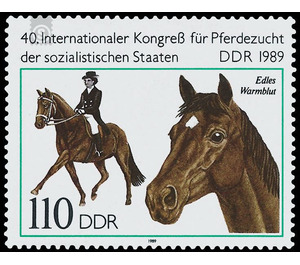40th International Congress for Horse Breeding of the Socialist States in the GDR in 1989 - Germany / German Democratic Republic 1989 - 110 Pfennig
Theme: Animals
| Country | Germany / German Democratic Republic |
| Issue Date | 1989 |
| Face Value | 110.00 |
| Color | brown |
| Perforation | K 13 1/2 |
| Printing Type | offset |
| Stamp Type | Postage stamp |
| Item Type | Stamp |
| Chronological Issue Number | 3006 |
| Chronological Chapter | GER-DDR |
| SID | 634299 |
| In 10 Wishlists | |
40th International Congress for the Breeding of the Socialist States, GDR 1989 On the occasion of the 40th International Congress for the Breeding of the Horse of the Socialist States in the GDR in 1989, the Ministry of Posts and Telecommunications of the German Democratic Republic publishes four multicolored special postage stamps. Special cancellation from 18 July to 17 September 1989 40th International Congress for the Breeding of the Socialist States, GDR 1989 The 40th International Congress for the Breeding of the Socialist States takes place from 22 to 28 August 1989 in Berlin, the capital city the GDR took place. Since 1949, the congress with the international thoroughbred meeting integrated into it has been held alternately annually in Moscow, Warsaw, Prague, Budapest and Berlin. It includes the organizations and institutions of the PR Bulgaria, the Hungarian VR, the GDR, the People's Republic of Poland, the SR Romania, the USSR and the CSSR, which are responsible for the management of horse breeding. The basic objectives of the Congress are to promote relations and cooperation between the socialist states in the field of scientific and technical progress in horse breeding. It deals with such tasks as the exchange of professional cadres, breeding animals and experience and scientific work on horse breeding and performance testing. The international thoroughbred meeting integrated into the congress serves as a comparison: the performance level in gallop racing between the participating socialist states. The issue of special postage stamps is intended to draw attention to the four main breeds of horses bred in the GDR. The motifs depict characteristic head portraits and a main direction of use for each horse breed. 10 Pfennig value: Haflinger The Haflinger originated from the down-to-earth mule horses in the Tyrol and developed at the beginning of the 20th century by crossing in Arabian horses. Since 1956, starting with imports from the original breeding area, the Haflinger is bred in the GDR as a multi-purpose small horse. Characteristic features are his chestnut color, and the white long hair. The versatility of the Haflinger finds its expression in the suitability for trail rides, carriage rides and other riding and tourist services as well as for light to medium-weight tractors in agriculture and forestry. 20 Pfennig value: Thoroughbred The genesis of the English Thoroughbred as a breed coincides with the beginning of a closed breeding in the year 1791. As English Thoroughbred horses today only such horses are recognized, which in their genealogy completely on the first published in the year 1793 Return the volume of the Generalstutbuch. The most important criterion in breeding selection is the horse's racing performance. Every year in the GDR about 700 racehorses are tested on the racetracks in Hoppegarten, Dresden, Leipzig, Halle, Magdeburg and Boxberg. These performance tests, which take place on 102 race days, are attended by about 500,000 citizens each year. 70-pfennig value: Draft blood The term "cold blood" is used internationally to summarize those populations that are bred and used primarily for the train service. In the GDR, mainly in the districts of Magdeburg, Erfurt and Cottbus, there is a high-quality cold-blooded breed, which can be traced back to the end of the 19th century. Genealogically, the current stock of down-to-earth material of Belgian-Brabant origin is composed. Due to the characteristic features of the cold-blooded is very well suited for all traction, especially in forestry. 1.10-Mark-Value: Noble Warmblood Since the beginning of the sixties the Noble Warmblood is bred in the GDR under cross breeding of breeds of the breed English Thoroughbred and Warmblood Trakehner descent. The main area of application of the noble warmblood is in the sporting field. The most important population in the GDR is due to its characteristic features ideal for all disciplines of equestrian sports. Especially in dressage, show jumping and driving, horses of the noble warm blood show their high performance in national and international tournaments. Jörn Oltmann, Berlin


